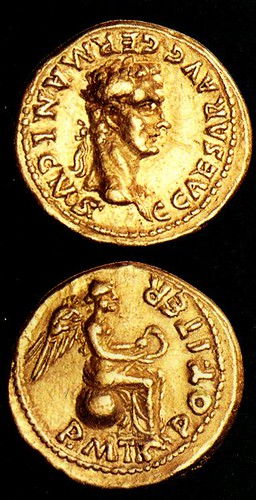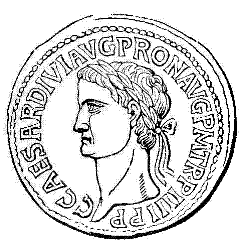Caligula, 16 March 37 - 24 January 41 A.D.

Caius Caesar was born in 12 A.D., the son of Germanicus and Agrippina Sr. He was nicknamed Caligula, meaning "little boots," by the legions because as a child his mother dressed him in military uniforms (including little boots). Initially he was very popular, succeeding Tiberius in 37 A.D. and for a few brief months ruling very well. However, an unknown disease drove him mad and his reign soon degenerated into debauchery and murder. He was murdered by the Praetorian Guard in 41 A.D.
Also see:
Caligula in Right Profile AR Denarii
Caligula Typology and First Living Princeps to Appear Radiate on Coinage
|Portraits| of Caligula The Seated Figure
The Lack of S.C. on Caligulan Sestertius
Franks Find!! With Metal Detector


Here are some details of the find. In fact, this denarius of Caligula is part of a small treasure of 20 denarii, scattered over a small area of semi-arid scrub land, near the ancient roman city of Nemausus (today Nimes). Thanks to the calcarious soil the coins did not suffer corrosion. Besides some broken roman tiles, the area was virgin. It was evidently a site where was located a small country house, modest in all ways and deserted ever since the first century AD. Through the wear of the coins, from republican denarii, gallion types of Marcus Antonius, several Augustus denarii and the common Tiberius denarius with Livia seated, it can easily be concluded that the 20 denarii were hidden or lost at one time, about 38 AD, because the wear of each coin was equivalent with the age as compared with the most recent one (of Caligula). Nothing else was found here, except a small copper Gallic coin, much older, and, since it was in superb condition, using the same wear/age considerations, was lost about a hundred years earlier. Knowing that the salary of a common soldier at that time was about one denarius a day, the amount of denarii found here was quite considerable. The brown margin on top of the reverse is concretion (some people mistakenly thought the coin is subaerate). As the above information is first-hand, I can guarantee the coin is genuine. For sentimental reasons the coin is not for sale, but Iíll be happy to contribute to numismatic science by publication of its image Regards Frank. This was sent to me by Frank where he found this denarius of Caligula. Frank granted portraitsofcaligula.com permission to use. These are Franks comments- Joe Geranio
Caligula Quinarius

The Very, Very Rare Caligula Quinarius!! Photo sent to Joe Geranio. I have yet to see one in person.
Detailed biography goes here
Obverse legends
CCAESARAVGPONMTRPOTIIICCAESARAVGGERMANICVSCCAESARAVGGERMANICVSPONMTRPOT
CCAESARAVGGERMPMTRPOT
CCAESARDIVIAVGPRONAVGPMTRPIIII
CCAESARDIVIAVGPRONAVGSC
CCAESARAVGPONMTRPOTIIICOSIII
CCAESARAVGGERMPMTRPOT
|Dictionary of Roman Coins|
        | Please |help| us convert the |Dictionary of Roman Coins| from scans to text by typing the original text here. Please add updates or make corrections to the NumisWiki text version as appropriate. Caligula, the grand nephew and murder of Tiberius, most worthy to succeed that emperor, because of an equally infamous, though not so able a tyrant, reigned from A.D. 37 to A.D. 41. |
Caligula, 16 March 37 - 24 January 41 A.D.

Caius Caesar was born in 12 A.D., the son of Germanicus and Agrippina Sr. He was nicknamed Caligula, meaning "little boots," by the legions because as a child his mother dressed him in military uniforms (including little boots). Initially he was very popular, succeeding Tiberius in 37 A.D. and for a few brief months ruling very well. However, an unknown disease drove him mad and his reign soon degenerated into debauchery and murder. He was murdered by the Praetorian Guard in 41 A.D.
Also see:
Caligula in Right Profile AR Denarii
Caligula Typology and First Living Princeps to Appear Radiate on Coinage
|Portraits| of Caligula The Seated Figure
The Lack of S.C. on Caligulan Sestertius
Franks Find!! With Metal Detector


Here are some details of the find. In fact, this denarius of Caligula is part of a small treasure of 20 denarii, scattered over a small area of semi-arid scrub land, near the ancient roman city of Nemausus (today Nimes). Thanks to the calcarious soil the coins did not suffer corrosion. Besides some broken roman tiles, the area was virgin. It was evidently a site where was located a small country house, modest in all ways and deserted ever since the first century AD. Through the wear of the coins, from republican denarii, gallion types of Marcus Antonius, several Augustus denarii and the common Tiberius denarius with Livia seated, it can easily be concluded that the 20 denarii were hidden or lost at one time, about 38 AD, because the wear of each coin was equivalent with the age as compared with the most recent one (of Caligula). Nothing else was found here, except a small copper Gallic coin, much older, and, since it was in superb condition, using the same wear/age considerations, was lost about a hundred years earlier. Knowing that the salary of a common soldier at that time was about one denarius a day, the amount of denarii found here was quite considerable. The brown margin on top of the reverse is concretion (some people mistakenly thought the coin is subaerate). As the above information is first-hand, I can guarantee the coin is genuine. For sentimental reasons the coin is not for sale, but Iíll be happy to contribute to numismatic science by publication of its image Regards Frank. This was sent to me by Frank where he found this denarius of Caligula. Frank granted portraitsofcaligula.com permission to use. These are Franks comments - Joe Geranio
The Very, Very Rare Caligula Quinarius!!

Photo sent to Joe Geranio. I have yet to see one in person - Joe Geranio.
Detailed biography goes here
Obverse legends
|Dictionary of Roman Coins|
        | Please |help| us convert the |Dictionary of Roman Coins| from scans to text by typing the original text here. Please add updates or make corrections to the NumisWiki text version as appropriate. Caligula, the grand nephew and murder of Tiberius, most worthy to succeed that emperor, because of an equally infamous, though not so able a tyrant, reigned from A.D. 37 to A.D. 41. |